You can create a test failover group to help you validate failover operations for virtual machines (VMs). With an array replication test failover group, you can perform test failover operations and undo test failover operations.
Before You Begin
Configure NetApp Open Replication.
Procedure
-
Log on to the Command Center.
-
From the navigation pane, go to Disaster recovery > Replication.
The Replication groups page appears.
-
On the Failover groups tab, in the upper-right area of the page, click Add failover group, and then click Array replication.
The Add failover group - Array replication page appears.
-
Enter the following information:
-
Name: Enter a descriptive name for the group.
-
Source hypervisor: Select the servers (hypervisors) to add all VMs that are part of the hypervisor.
-
Operation type: Select Test failover.
-
Storage policy/copy: Select the primary snap copy that you want to use.
-
Destination hypervisor: Select the destination server for the VMs.
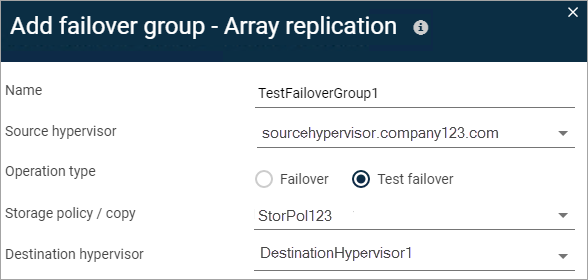
-
-
Configure the virtual machines that you want to use in the test failover group.
-
Beside Virtual Machines, click Add.
The Add machines dialog box appears
-
Select the VMs that you want to make available for use in the test failover group, and then click Save.
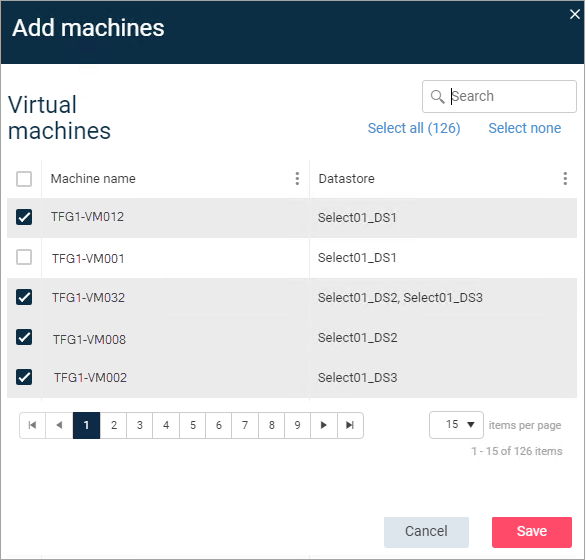
-
-
Under ESX server mapping, configure at least one network.
-
Beside Source - Destination, click Add.
The ESX browse page appears.
-
Configure the server mapping settings:
-
Source: Click Browse, select a server, and then click OK.
-
Destination host: Click Browse, select a server, and then click OK.
-
Source network: Select the network to use for the source server.
-
Destination network: Select the network to use for the destination server.
-
-
Click Add to list.
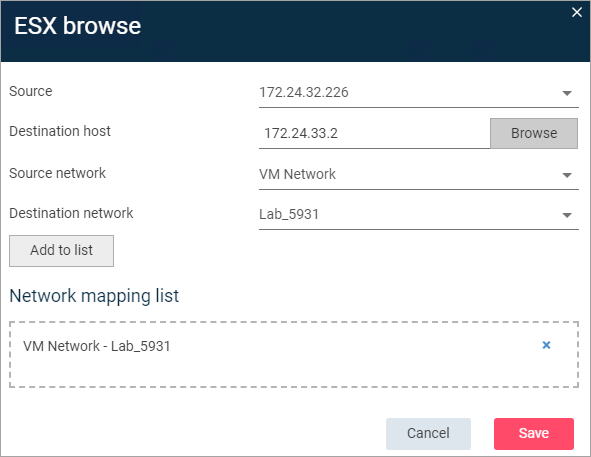
-
Click Save.
-
-
Optional: Configure the IP address settings for the VMs you selected.
-
Under Virtual machines, right-click a VM and select Configure IP address.
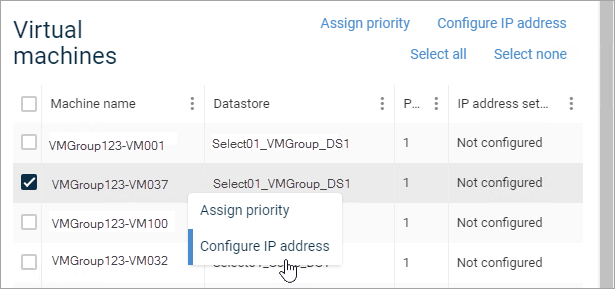
The Configure VM dialog box appears.
-
Under IP address settings, click Add.
The IP address settings dialog box appears.
-
Configure the Source VM settings:
-
IP address: Enter the IP address that you want to use for the source VM.
-
Subnet mask: Enter the subnet mask that you want to use to mask the IP for the source VM.
-
Default gateway: Enter the IP address to use as the default gateway for the source VM.
-
-
Configure the Destination VM settings:
-
Use DHCP: Move the toggle key to the right to use DHCP to automatically assign an IP address to the destination VM.
When you select this option, you cannot configure any additional IP addresses, DNS servers, or WINS servers.
-
IP address: Enter the IP address that you want to use for the destination VM.
-
Subnet mask: Enter the subnet mask that you want to use to mask the IP for the destination VM.
-
Default gateway: Enter the IP address to use as the default gateway for the destination VM.
-
Preferred DNS server: Enter the IP address for your preferred DNS server.
-
Alternate DNS server: Enter the IP address to use as an alternate DNS server.
-
Preferred WINS server: Enter the IP address for your preferred WINS server.
-
Alternate WINS server: Enter the IP address to use as an alternate WINS server.
-
-
Click OK.
-
Under IP address settings, select the source IP and destination IP pair that you want to use.
-
To configure a host name for the destination server, beside Destination hostname, type a host name.
-
Click Save.
Note
If you want to configure the IP address settings for more than one VM, you must select each VM individually. You cannot configure IP address settings for multiple VMs at the same time.
-
-
Optional: Assign the priority for creating each VM on the destination server:
-
Under Virtual machines, right-click a VM and select Assign priority.
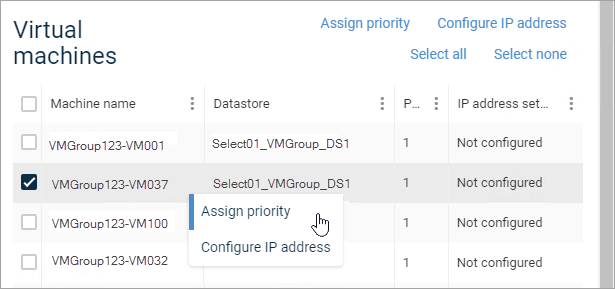
The Assign priority dialog box appears.
-
Beside Priority, enter the priority for creating the VM, and then click Save.
-
-
Optional: Configure Advanced settings for the failover group:
-
Delay between different priority machines (in mins): Enter the number of minutes to wait before creating the next VM.
-
Continue to next priority on failure: To start creating the next priority VM even if the previous VM fails to build, move the toggle key to the right.
Note
Even if you leave the check box beside one or more individual VMs cleared under Virtual machines, all VMs that appear in the list are included in the array replication test failover group. If you want to exclude any of the listed VMs from the array replication test failover group, then delete the VM from the Virtual machines list.
-
-
Click Save.